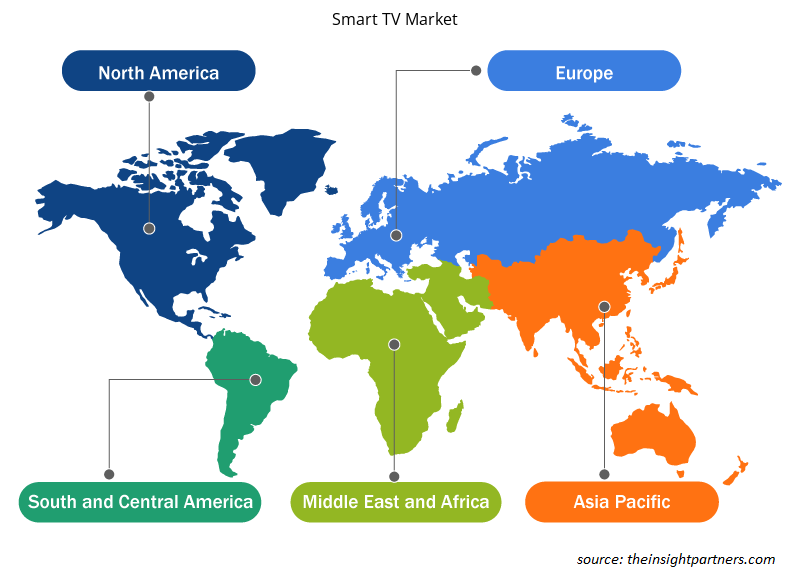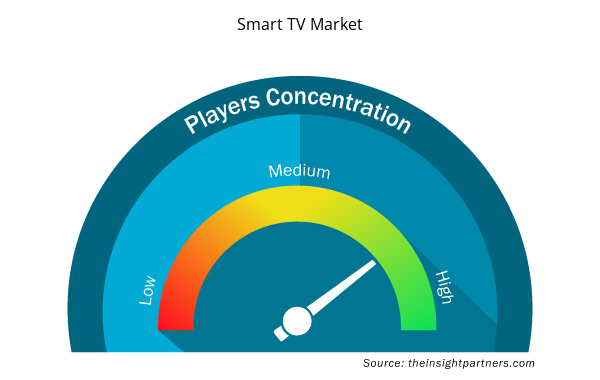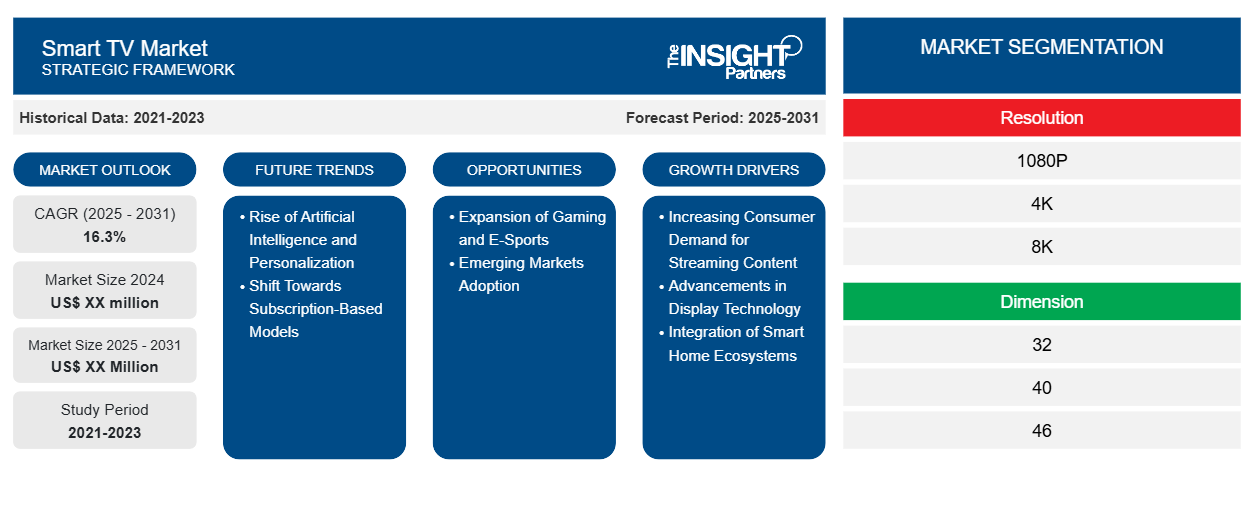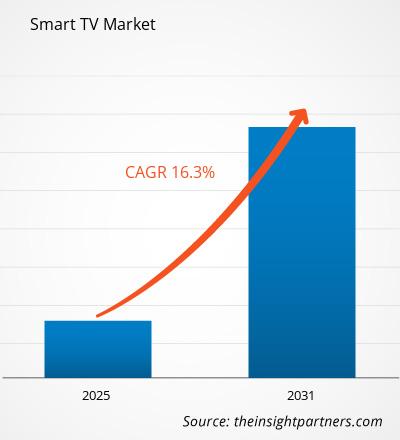スマートテレビ市場は、2024年から2031年にかけて16.3%のCAGRで成長すると予想されており、市場規模は2024年のXX百万米ドルから2031年にはXX百万米ドルに拡大する見込みです。
レポートは、解像度(1080P、4K、8K、その他)、寸法(32、40、46、55、75以上)、ダイナミックレンジ(標準、HDR)、アプリケーション(住宅、商業)でセグメント化されています。グローバル分析は、地域レベルと主要国でさらに細分化されています。レポートでは、上記の分析とセグメントの値をUSDで提供しています。
報告書の目的
The Insight Partners によるスマート TV 市場のレポートは、現在の状況と将来の成長、主な推進要因、課題、機会を説明することを目的としています。これにより、次のようなさまざまなビジネス関係者に洞察が提供されます。
- テクノロジープロバイダー/メーカー: 進化する市場の動向を理解し、潜在的な成長機会を把握することで、情報に基づいた戦略的意思決定が可能になります。
- 投資家: 市場の成長率、市場の財務予測、バリュー チェーン全体に存在する機会に関する包括的な傾向分析を実施します。
- 規制機関: 市場の濫用を最小限に抑え、投資家の信用と信頼を維持し、市場の完全性と安定性を維持することを目的として、市場における政策と警察活動を規制します。
スマートテレビ市場のセグメンテーション
解決
- 1080P
- 4K
- 8K
- その他
寸法
- 32
- 40
- 46
- 55
- 75歳以上
ダイナミックレンジ
- 標準
- 高解像度
応用
- 居住の
- コマーシャル
要件に合わせてレポートをカスタマイズする
このレポートの一部、国レベルの分析、Excelデータパックなど、あらゆるレポートを無料でカスタマイズできます。また、スタートアップや大学向けのお得なオファーや割引もご利用いただけます。
- このレポートの主要な市場動向を入手してください。この無料サンプルには、市場動向から見積もりや予測に至るまでのデータ分析が含まれます。
スマートテレビ市場の成長要因
- ストリーミング コンテンツに対する消費者の需要の高まり: Netflix、Hulu、Amazon Prime Video などのストリーミング サービスの人気の高まりは、スマート TV 市場の大きな推進力となっています。消費者は、映画、TV 番組、ライブ スポーツなど、さまざまなオンライン コンテンツにシームレスにアクセスできるデバイスを求めるようになっています。統合アプリとユーザー フレンドリーなインターフェイスを備えたスマート TV は、直接ストリーミング機能を提供することでこの需要に応えています。従来のケーブル サブスクリプションから離れる世帯が増えるにつれて、視聴体験を向上させるスマート TV への要望は高まり続け、市場の売上を押し上げています。
- ディスプレイ技術の進歩: 4K、OLED、QLED などのディスプレイ技術の継続的な進歩により、スマート TV 市場が前進しています。これらの技術により画質が向上し、消費者はより鮮明な画像、鮮やかな色、改善されたコントラストを享受できます。メーカーが革新を起こして新機能を導入するにつれ、消費者は優れた視聴体験を提供する高性能スマート TV にますます惹かれるようになっています。さらに、高解像度コンテンツの利用可能性が高まったことで、高度なディスプレイ技術の採用が促進され、市場でのスマート TV の需要がさらに高まっています。
- スマートホームエコシステムの統合: スマートホームオートメーションのトレンドが拡大し、スマートテレビ市場に大きな影響を与えています。消費者は、音声アシスタント (Amazon Alexa、Google Assistant など) やホームオートメーション製品など、既存のスマートホームシステムとシームレスに統合できるデバイスを求めています。さまざまなスマートホームデバイスとの互換性を備えたスマートテレビは、利便性を高め、ユーザーエクスペリエンスを向上させます。市場が進化するにつれて、スマートテレビを通じてスマートホーム機能を制御する機能が不可欠な機能になりつつあり、消費者の関心を高め、市場の成長を促進しています。
スマートテレビ市場の今後の動向
- 人工知能とパーソナライゼーションの台頭: スマート TV への人工知能 (AI) の統合は顕著なトレンドになりつつあり、パーソナライズされたコンテンツの推奨とよりスマートなインターフェースを通じてユーザー エクスペリエンスが向上しています。AI アルゴリズムは視聴習慣と好みを分析して、関連する番組、映画、アプリケーションを提案し、ユーザーが新しいコンテンツを見つけやすくします。スマート TV がより直感的になり、個人の好みに応答するようになるにつれて、このトレンドは消費者の期待を形成し、スマート TV 市場のさらなる革新を促進すると予想されます。
- サブスクリプション ベースのモデルへの移行: スマート TV でのコンテンツ配信では、サブスクリプション ベースのモデルへの移行が進んでいます。多くの消費者は、従来のケーブル パッケージに加入するよりも、さまざまなストリーミング サービスに加入する柔軟性を好みます。この移行により、消費者が 1 つのパッケージで複数のプラットフォームにアクセスできるバンドル サブスクリプション サービスが登場しています。この傾向が勢いを増すにつれ、スマート TV メーカーはストリーミング サービスとの提携を模索して独占バンドルを提供し、消費者に対する全体的な価値提案を強化してスマート TV の売上を伸ばす可能性が高くなります。
スマートテレビの市場機会
- ゲームと e スポーツの拡大: 急成長を遂げているゲーム業界は、スマート TV 市場にとって大きなチャンスです。オンライン ゲームと e スポーツの台頭により、消費者は高リフレッシュ レート、低遅延、没入感あふれるグラフィックスを提供するスマート TV を求めるようになっています。メーカーは、専用のゲーム モードと人気のゲーム コンソールとの互換性を備え、ゲーム体験に特化して最適化されたスマート TV を設計することで、このトレンドを活用できます。ゲーム ユーザー層をターゲットにすることで、企業は市場範囲を拡大し、この成長分野での売上を伸ばすことができます。
- 新興市場での採用: スマート TV の新興市場への拡大は、大きな成長の機会となります。アジア太平洋、アフリカ、ラテンアメリカなどの地域では可処分所得が増加し、インターネットの普及が進むにつれて、エンターテイメント システムのアップグレードを検討する消費者が増えています。企業は、ローカライズされたコンテンツを備えた手頃な価格のスマート TV オプションを提供するなど、マーケティング戦略と製品提供をこれらの市場の独自のニーズと好みに合わせて調整できます。新興市場へのこの戦略的重点は、大幅な売上成長を促進し、世界的なブランド プレゼンスを高めることができます。
スマートテレビ市場の地域別分析
予測期間を通じてスマート TV 市場に影響を与える地域的な傾向と要因は、Insight Partners のアナリストによって徹底的に説明されています。このセクションでは、北米、ヨーロッパ、アジア太平洋、中東およびアフリカ、南米および中米にわたるスマート TV 市場のセグメントと地理についても説明します。

- スマートテレビ市場の地域別データを入手
スマートテレビ市場レポートの範囲
| レポート属性 | 詳細 |
|---|---|
| 2024年の市場規模 | XX百万米ドル |
| 2031年までの市場規模 | XX百万米ドル |
| 世界のCAGR(2025年~2031年) | 16.3% |
| 履歴データ | 2021-2023 |
| 予測期間 | 2025-2031 |
| 対象セグメント | 決議により
|
| 対象地域と国 | 北米
|
| 市場リーダーと主要企業プロフィール |
|
スマートテレビ市場のプレーヤー密度:ビジネスダイナミクスへの影響を理解する
スマート TV 市場は、消費者の嗜好の変化、技術の進歩、製品の利点に対する認識の高まりなどの要因により、エンドユーザーの需要が高まり、急速に成長しています。需要が高まるにつれて、企業は提供内容を拡大し、消費者のニーズを満たすために革新を起こし、新たなトレンドを活用し、市場の成長をさらに促進しています。
市場プレーヤー密度とは、特定の市場または業界内で活動している企業または会社の分布を指します。これは、特定の市場スペースに、その市場規模または総市場価値に対してどれだけの競合相手 (市場プレーヤー) が存在するかを示します。
スマートテレビ市場で事業を展開している主要企業は次のとおりです。
- アップル
- 日立製作所
- ハイアール株式会社
- フィリップスNV
- LGエレクトロニクス
- TCL
免責事項:上記の企業は、特定の順序でランク付けされていません。

- スマートテレビ市場のトップキープレーヤーの概要を入手
主なセールスポイント
- 包括的なカバレッジ: レポートでは、スマート TV 市場の製品、サービス、タイプ、エンド ユーザーの分析を包括的にカバーし、全体的な概要を提供します。
- 専門家による分析: レポートは、業界の専門家とアナリストの深い理解に基づいてまとめられています。
- 最新情報: このレポートは、最新の情報とデータの傾向を網羅しているため、ビジネスの関連性を保証します。
- カスタマイズ オプション: このレポートは、特定のクライアント要件に対応し、ビジネス戦略に適切に適合するようにカスタマイズできます。
したがって、スマート TV 市場に関する調査レポートは、業界のシナリオと成長の見通しを解読し理解する道の先導役となる可能性があります。正当な懸念事項がいくつかあるかもしれませんが、このレポートの全体的な利点は欠点を上回る傾向があります。
- 過去2年間の分析、基準年、CAGRによる予測(7年間)
- PEST分析とSWOT分析
- 市場規模価値/数量 - 世界、地域、国
- 業界と競争環境
- Excel データセット



Report Coverage
Revenue forecast, Company Analysis, Industry landscape, Growth factors, and Trends

Segment Covered
This text is related
to segments covered.

Regional Scope
North America, Europe, Asia Pacific, Middle East & Africa, South & Central America

Country Scope
This text is related
to country scope.
よくある質問
The report can be delivered in PDF/PPT format; we can also share excel dataset based on the request
Some of the customization options available based on the request are an additional 3-5 company profiles and country-specific analysis of 3-5 countries of your choice. Customizations are to be requested/discussed before making final order confirmation# as our team would review the same and check the feasibility
Growth of over-the-top (OTT) services and integration of smart features are the major factors driving the smart TV market.
Integration with smart home ecosystems is likely to remain a key trend in the market.
The Smart TV Market is estimated to witness a CAGR of 16.3% from 2023 to 2031
Trends and growth analysis reports related to Electronics and Semiconductor : READ MORE..
The List of Companies
1. Apple Inc.
2. Hitachi Ltd
3. Haier Inc
4. Koninklijke Philips N.V.
5. LG Electronics
6. TCL
7. Panasonic Corporation
8. SAMSUNG
9. Sony Corporation
10. Toshiba Visual Solutions Corporation
The Insight Partners performs research in 4 major stages: Data Collection & Secondary Research, Primary Research, Data Analysis and Data Triangulation & Final Review.
- Data Collection and Secondary Research:
As a market research and consulting firm operating from a decade, we have published and advised several client across the globe. First step for any study will start with an assessment of currently available data and insights from existing reports. Further, historical and current market information is collected from Investor Presentations, Annual Reports, SEC Filings, etc., and other information related to company’s performance and market positioning are gathered from Paid Databases (Factiva, Hoovers, and Reuters) and various other publications available in public domain.
Several associations trade associates, technical forums, institutes, societies and organization are accessed to gain technical as well as market related insights through their publications such as research papers, blogs and press releases related to the studies are referred to get cues about the market. Further, white papers, journals, magazines, and other news articles published in last 3 years are scrutinized and analyzed to understand the current market trends.
- Primary Research:
The primarily interview analysis comprise of data obtained from industry participants interview and answers to survey questions gathered by in-house primary team.
For primary research, interviews are conducted with industry experts/CEOs/Marketing Managers/VPs/Subject Matter Experts from both demand and supply side to get a 360-degree view of the market. The primary team conducts several interviews based on the complexity of the markets to understand the various market trends and dynamics which makes research more credible and precise.
A typical research interview fulfils the following functions:
- Provides first-hand information on the market size, market trends, growth trends, competitive landscape, and outlook
- Validates and strengthens in-house secondary research findings
- Develops the analysis team’s expertise and market understanding
Primary research involves email interactions and telephone interviews for each market, category, segment, and sub-segment across geographies. The participants who typically take part in such a process include, but are not limited to:
- Industry participants: VPs, business development managers, market intelligence managers and national sales managers
- Outside experts: Valuation experts, research analysts and key opinion leaders specializing in the electronics and semiconductor industry.
Below is the breakup of our primary respondents by company, designation, and region:

Once we receive the confirmation from primary research sources or primary respondents, we finalize the base year market estimation and forecast the data as per the macroeconomic and microeconomic factors assessed during data collection.
- Data Analysis:
Once data is validated through both secondary as well as primary respondents, we finalize the market estimations by hypothesis formulation and factor analysis at regional and country level.
- Macro-Economic Factor Analysis:
We analyse macroeconomic indicators such the gross domestic product (GDP), increase in the demand for goods and services across industries, technological advancement, regional economic growth, governmental policies, the influence of COVID-19, PEST analysis, and other aspects. This analysis aids in setting benchmarks for various nations/regions and approximating market splits. Additionally, the general trend of the aforementioned components aid in determining the market's development possibilities.
- Country Level Data:
Various factors that are especially aligned to the country are taken into account to determine the market size for a certain area and country, including the presence of vendors, such as headquarters and offices, the country's GDP, demand patterns, and industry growth. To comprehend the market dynamics for the nation, a number of growth variables, inhibitors, application areas, and current market trends are researched. The aforementioned elements aid in determining the country's overall market's growth potential.
- Company Profile:
The “Table of Contents” is formulated by listing and analyzing more than 25 - 30 companies operating in the market ecosystem across geographies. However, we profile only 10 companies as a standard practice in our syndicate reports. These 10 companies comprise leading, emerging, and regional players. Nonetheless, our analysis is not restricted to the 10 listed companies, we also analyze other companies present in the market to develop a holistic view and understand the prevailing trends. The “Company Profiles” section in the report covers key facts, business description, products & services, financial information, SWOT analysis, and key developments. The financial information presented is extracted from the annual reports and official documents of the publicly listed companies. Upon collecting the information for the sections of respective companies, we verify them via various primary sources and then compile the data in respective company profiles. The company level information helps us in deriving the base number as well as in forecasting the market size.
- Developing Base Number:
Aggregation of sales statistics (2020-2022) and macro-economic factor, and other secondary and primary research insights are utilized to arrive at base number and related market shares for 2022. The data gaps are identified in this step and relevant market data is analyzed, collected from paid primary interviews or databases. On finalizing the base year market size, forecasts are developed on the basis of macro-economic, industry and market growth factors and company level analysis.
- Data Triangulation and Final Review:
The market findings and base year market size calculations are validated from supply as well as demand side. Demand side validations are based on macro-economic factor analysis and benchmarks for respective regions and countries. In case of supply side validations, revenues of major companies are estimated (in case not available) based on industry benchmark, approximate number of employees, product portfolio, and primary interviews revenues are gathered. Further revenue from target product/service segment is assessed to avoid overshooting of market statistics. In case of heavy deviations between supply and demand side values, all thes steps are repeated to achieve synchronization.
We follow an iterative model, wherein we share our research findings with Subject Matter Experts (SME’s) and Key Opinion Leaders (KOLs) until consensus view of the market is not formulated – this model negates any drastic deviation in the opinions of experts. Only validated and universally acceptable research findings are quoted in our reports.
We have important check points that we use to validate our research findings – which we call – data triangulation, where we validate the information, we generate from secondary sources with primary interviews and then we re-validate with our internal data bases and Subject matter experts. This comprehensive model enables us to deliver high quality, reliable data in shortest possible time.


 このレポートの無料サンプルを入手する
このレポートの無料サンプルを入手する